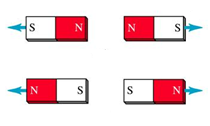A permanent magnet is an object that retains its magnetization for a long period of time.
A magnetic field exists around a magnetized object. This magnetic field exerts a magnetic force on another magnetized object.
The locations on a magnet with the greatest magnetic effect are called the magnet’s poles. Each magnet has two poles: a north (N) pole and a south (S) pole.
Like poles of magnets repel each other, while opposite poles attract each other.
It is impossible to obtain a magnet with only one pole.
By holding a permanent magnet near various objects made of different materials, it can be observed that only a few of them are attracted to the magnet. Materials such as iron, steel, cast iron, and certain alloys are strongly attracted to a magnet, and they are called ferromagnetic materials. Nickel and cobalt are also ferromagnetic, but to a lesser extent.
Materials such as paper, glass, plastic, and copper are not attracted to a magnet.
When a permanent magnet is heated to a certain temperature, its magnetic properties disappear. The temperature at which permanent magnets lose their magnetic properties is called the Curie temperature.
| Metal | Curie temperature С∘ |
| iron | 769 |
| cobalt | 1130 |
| nickel | 358 |
Natural magnets, also known as lodestones, can be found in nature. Lodestones allowed humans to discover the magnetic properties of materials. In addition to permanent magnets, there are also electromagnets, which require an electric current to be applied to have magnetic properties.
Magnets are used in electrical engineering, radio engineering, communication technology, radar systems, automatic control devices, magnetic separation, and more.
Ferrite magnets are one of the materials that are most widely used for permanent magnets.
One of the first applications of magnets was magnetic compasses, whose needles pointed to the direction of the Earth’s magnetic poles.


